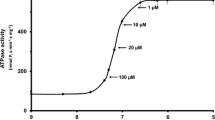Summary
The requirement of calcium (Ca2+) in the excitation-contraction coupling of both skeletal and cardiac muscle is well established. However, the exact location of the intracellular storage sites of Ca2+ is not firmly established. We report here on the ultrastructural distribution of Ca2+ in white and red skeletal muscle and in cardiac muscle of the rat using combined phosphate-pyroantimonate (PPA) and oxalate-pyroantimonate (OPA) procedures. The methods are based on (a) stabilization and/or trapping of Ca2+ during the primary fixation step in glutaraldehyde by potassium phosphate or oxalate; (b) subsequent wash-out of all non-trapped cations such as Na+ and Mg2+ in potassium phosphate or oxalate; (c) conversion of the complexed or trapped Ca2+ into an electron-dense calcium pyroantimonate salt in 100 μm-thick tissue sections; and (d) wash-out of the excess potassium pyroantimonate at alkaline pH.
With the OPA procedure, mitochondria of all muscle types showed little precipitate. The junctional sarcoplasmic reticulum was stongly reactive in relaxed white skeletal muscle, negative in contracted white fibres and negative in red skeletal and cardiac muscle, independent of the state of relaxation-contraction. Other organelles were essentially free of deposits.
With the PPA method, the precipitate was almost exclusively confined to the sarcolemma and its T-tubular invaginations in cardiac and slow skeletal muscle, and was absent in fast skeletal muscle. Apart from occasional deposits in mitochondria, all other organelles were free of precipitate. The sarcolemma-associated deposits were clearly confined to the inner leaflet of the lipid bilayer. The amount of precipitate varied within the contraction cycle, relaxed cells possessing the highest density.
Exposure of the tissue to La3+ resulted in the complete absence of sarcolemma-bound precipitate suggesting that the Ca2+ is exchangeable. Furthermore, these cytological data suggest a basic difference in Ca2+ storage between white skeletal muscle on the one hand, and red skeletal and cardiac muscle on the other.
Similar content being viewed by others
References
Borgers, M. (1981) The role of calcium in the toxicity of the myocardium.Histochem. J. 13, 839–48.
Borgers, M., De Brabander, M., Van Reempts, J., Awouters, F. &Jacob, W. (1977) Intranuclear microtubules in lung mast cells of guinea-pigs in anaphylactic shock.Lab. Invest. 37, 1–8.
Borgers, M., Thone, F. &Van Nueten, J. (1981) The subcellular distribution of calcium and the effects of calcium-antagonists as evaluated with a combined oxalate-pyroantimonate technique.Acta Histochem. 24, 327–33.
Borgers, M., Thone, F., Verheyen, A. &Ter Keurs, H. (1982) Localization of calcium in cardiac and skeletal muscle.J. Cell Biol. 95, 360a.
Borgers, M., Thone, F. J. M., Xhonneux, B. J. M. &De Clerck, F. F. P. (1983) Localization of calcium in red blood cells.J. Histochem. Cytochem. 31, 1109–16.
Boskey, A. L. &Posner, A. S. (1982) Optimal conditions for Ca-acidic phospholipid-PO4 formation.Calcif. Tiss. Int. 34, S1-S7.
Buckley, J. T. &Hawthorne, J. N. (1972) Erythrocyte membrane polyphosphoinositide metabolism and the regulation of calcium binding.J. biol. Chem. 247, 7218–23.
Chandler, J. A. (1973) The use of wavelength dispersive X-ray microanalysis in cytochemistry. InElectron Microscopy and Cytochemistry (edited byWisse, E., Daems, W. Th., Molenaer, I. andVan Duijn, P.) pp. 203–22. Amsterdam: North-Holland Publishing Co.
Constantin, L. L., Franzini-Armstrong, C. &Podolsky, R. J. (1965) Localization of calcium-accumulating structures in striated muscle fibers.Science 147, 158–60.
Dawson, R. H. C. (1965) “Phosphatido-peptide”-like complexes formed by the interaction of calcium triphosphoinositide with protein.Biochem. J. 97, 134–8.
Disulesci, I., Popescu, L. M., Ionescu, N. &Butucescu, N. (1971) Ultrastructural study of calcium distribution in cardiac muscle cells.Z. Zellforsch. 121, 181–98.
Eisenberg, B. R. &Kuda, A. M. (1976) Discrimination between fiber populations in mammalian skeletal muscle by using ultrastructural parameters.J. Ultrastruct. Res. 54, 76–88.
Flameng, W., Daenen, W., Borgers, M., Thone, F., Xhonneux, R., Van de Water, A. &Van Belle, H. (1981) Cardioprotective effects of lidoflazine during 1 hour normothermic global ischemia.Circulation 64, 796–807.
Hendrickson, H. S. &Fullington, J. G. (1965) Stabilities of metal complexes of phospholipids: Ca (II), Mg (II) and Ni (II) complexes of phosphatidylserine and triphosphoinositide.Biochemistry 4, 1599–605.
Katz, H. M. (1977)Physiology of the Heart. New York: Raven Press.
Komnick, H. (1962) Elektronenmikroskopische Lokalisation von Na+ und Cl− in Zellen und Geweben.Protoplasma 55, 414–22.
Langer, G. A., Frank, J. S. &Phillipson, K. D. (1982) Ultrastructure and calcium exchange of the sarcolemma, sarcoplasmic reticulum and mitochondria of the myocardiumPharmac. Ther. 16, 331–76.
Larsen, W. J. (1975) Opaque deposits on gap junction membranes after glutaraldehyde-calcium fixation.J. Cell Biol. 67, 801–13.
Lüllman, H. &Peters, T. (1977) Plasmalemmal calcium in cardiac excitation-contraction coupling.Clin. Exp. Pharm. Physiol. 4, 49–57.
Oschmann, J. L. &Wall, B. J. (1972) Calcium binding to intestinal membranes.J. Cell Biol. 55, 58–73.
Phillipson, K. D., Bers, D. H. &Nishinato, A. Y. (1980) The role of phospholipids in the Ca2+-binding of isolated cardiac sarcolemma.J. Mol. Cell Cardiol. 12, 1159–73.
Riley, D. A., Ellis, S. &Bain, J. (1982) Carbonic anhydrase activity in skeletal muscle fiber types, axons, spindles, and capillaries of rat soleus and extensor digitorum longus muscles.J. Histochem. Cytochem. 30, 1275–88.
Somlyo, A. V., Gonzalez-Serratos, Shuman, H., McClellan, G. &Somlyo, A. P. (1981) Calcium release and ionic changes in the sarcoplasmic reticulum of tetanized muscle. An electron-probe analysis.J. Cell Biol. 90, 577–94.
Van Reempts, J. &Borgers, M. (1983) Morphologic aspects of brain protection in experimentally induced ischemia. InBrain Protection (edited byWiedemann, K. andHoyer, S.), pp. 12–24. Berlin: Springer-Verlag.
Van Reempts, J., Borgers, M. &Offner, F. (1982) Ultrastructural localizations of calcium in the rat retina with a combined oxalate-pyroantimonate technique.Histochem. J. 14, 517–22.
Wick, S. M. &Hepler, P. K. (1982) Selective localization of intracellular Ca2+ with potassium antimonate.J. Histochem. Cytochem. 30, 1190–204.
Wohlfart, B. &Noble, M. I. M. (1982) The cardiac excitation-contraction cycle.Pharmac. Ther. 16, 1–32.
Author information
Authors and Affiliations
Rights and permissions
About this article
Cite this article
Borgers, M., Thone, F., Verheyen, A. et al. Localization of calcium in skeletal and cardiac muscle. Histochem J 16, 295–309 (1984). https://doi.org/10.1007/BF01003613
Received:
Revised:
Issue Date:
DOI: https://doi.org/10.1007/BF01003613




